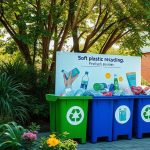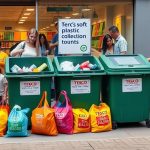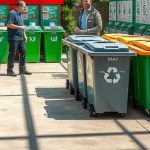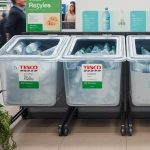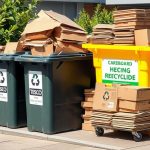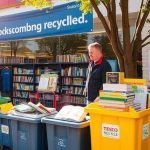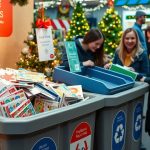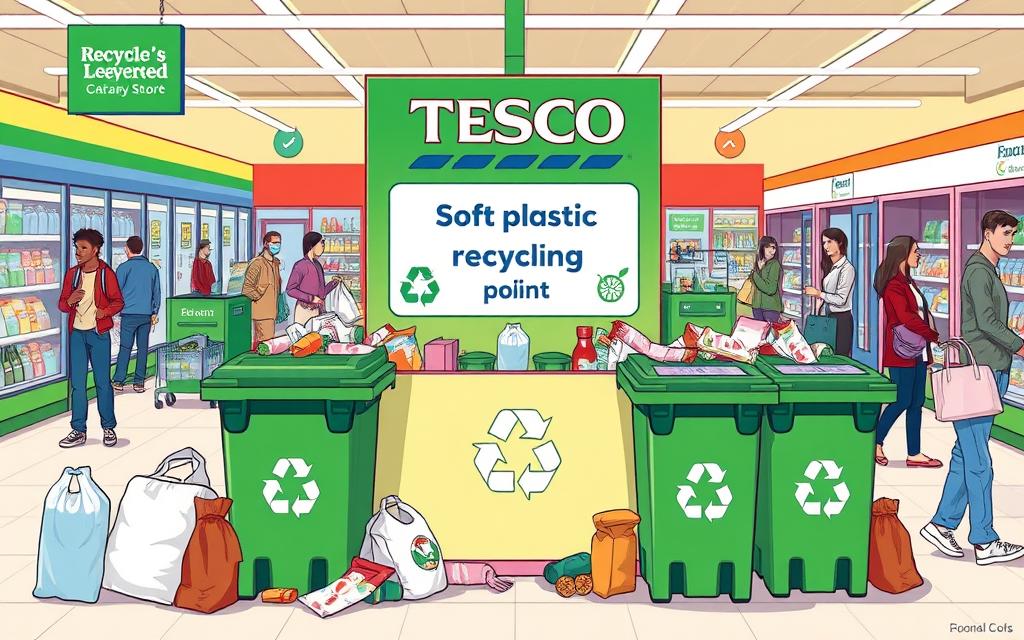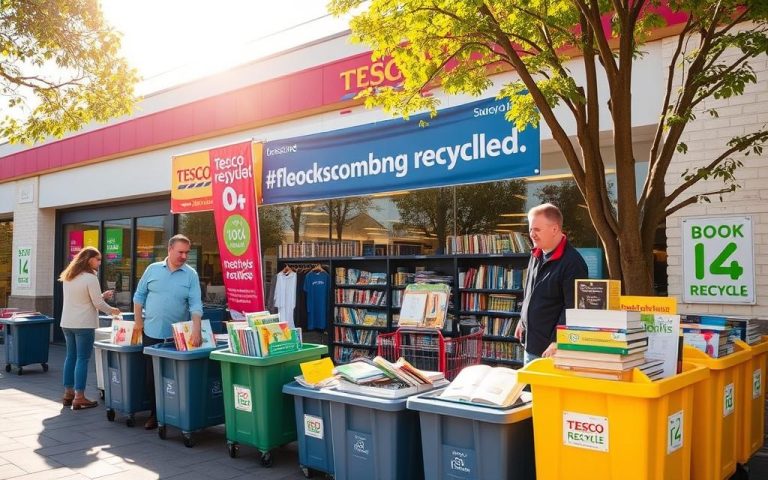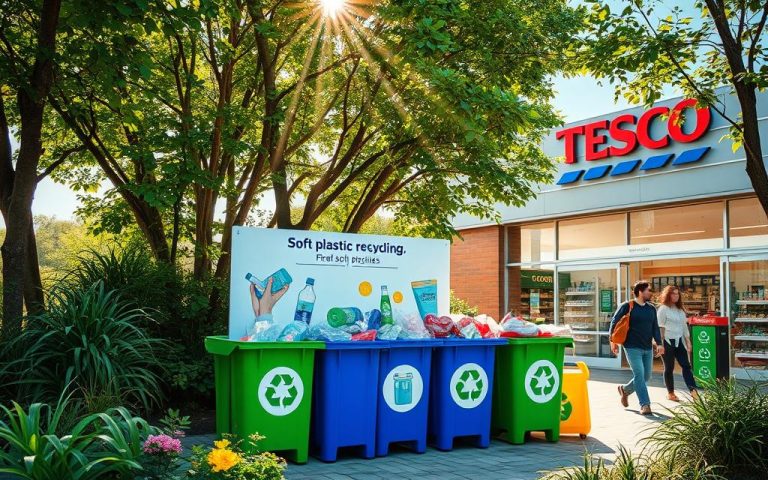Tesco.com Recycling: Everything You Need to Know
Tesco’s recycling initiative is a game-changer for UK retail sustainability. They’ve removed nearly 1.5 billion plastic pieces from their operations. This shows their strong commitment to protecting the environment.
The supermarket has transformed its packaging practices. They’ve saved over 6,000 tonnes of packaging material. Tesco has also improved packaging for more than 1,600 products.
Shoppers are looking for eco-friendly shopping options. Tesco’s recycling programme meets this need. They’ve set up innovative collection points across the UK.
Tesco goes beyond simple waste management. They’re encouraging customers to join in sustainable practices. This helps reduce overall environmental impact.
Tesco tackles complex recycling challenges head-on. They focus on hard-to-recycle materials. These materials often end up in landfills.
Understanding Tesco’s Recycling Initiative
Tesco leads the way in sustainable retail with innovative recycling programmes. The supermarket chain has transformed its packaging and waste management approach. It’s making significant strides to reduce its environmental impact.
Tesco’s commitment to recyclable materials has yielded impressive results. Since 2019, they’ve eliminated over 3,000 tonnes of packaging. They’ve also removed 1.7 billion plastic pieces from UK operations.
What Materials Can Be Recycled at Tesco
Tesco recycling points now accept various materials. This makes sustainable disposal convenient for customers.
- Soft plastics (crisp packets, bread bags)
- Flexible food packaging
- Plastic film and wrapping
- Selected packaging from own-brand products
Store Locations with Recycling Facilities
Tesco has recycling points in nearly 200 stores across South West England and Wales. Customers can easily spot these dedicated recycling stations in participating stores.
The Environmental Impact
Tesco’s environmental strategy extends beyond simple recycling. The company has adopted a comprehensive approach to sustainability.
| Initiative | Environmental Benefit |
|---|---|
| Recycled PET Packaging | 30% of rPET used in own-brand packaging |
| Annual Plastic Recycling | 2,000 tonnes of PET recycled |
| Plastic Reduction Goal | Remove 500 million plastic pieces |
“Our goal is to create a circular economy where packaging becomes a resource, not waste.” – Tesco Sustainability Team
Tesco’s recyclable materials programmes actively reduce landfill waste. They’re promoting a more sustainable future for retail packaging. These efforts contribute to a cleaner environment and a circular economy.
Tesco.com Recycling: Soft Plastics Collection Programme
Tesco has launched a ground-breaking soft plastics recycling initiative. This programme aims to transform how people recycle packaging. Customers can now recycle seven types of soft plastic packaging in Tesco stores.
The programme covers various packaging types. These include cling film, bread bags, and pet food pouches. It also accepts baby food pouches, crisp packets, salad bags, and fruit packaging.
“Our commitment is to create a sustainable solution for plastic waste that empowers customers to make environmentally conscious choices,” says Tesco’s sustainability team.
Tesco’s initial trial showed impressive results. Over 171 stores collected nearly one tonne of soft plastic daily. The programme recovered over 80% of returned soft plastics.
Tesco plans to collect more than 1,000 tonnes of soft plastics annually. Customers can bring their soft plastic packaging to designated collection points. This initiative is a big step towards creating a circular economy.
The programme aims to turn waste into new packaging materials. This approach will help reduce the impact on our environment. It’s an exciting development in the fight against plastic waste.
Common Recycling Symbols and Their Meanings
Recycling symbols can be confusing. This guide will help you understand packaging markings. You’ll be able to make better decisions about waste disposal.
These symbols are vital for effective recycling. They show recyclability, material composition, and special handling instructions. Understanding them helps you recycle properly.
The Mobius Loop and Plastic Resin Codes
The Mobius Loop is the most well-known recycling symbol. It shows that packaging can be recycled. However, local collection isn’t always guaranteed.
When paired with a percentage, it shows the amount of recycled content. Plastic resin codes give important details about plastic types.
| Code | Plastic Type | Recyclability |
|---|---|---|
| 1 (PET) | Polyethylene Terephthalate | Widely Recycled |
| 2 (HDPE) | High-Density Polyethylene | Widely Recycled |
| 3 (PVC) | Polyvinyl Chloride | Difficult to Recycle |
| 4 (LDPE) | Low-Density Polyethylene | Specialised Collection |
| 5 (PP) | Polypropylene | Widely Recycled |
| 6 (PS) | Polystyrene | Difficult to Recycle |
Specialist Recycling Symbols
- Crossed-out Wheelie Bin: Indicates electrical items must be returned to specific recycling points
- Forest Stewardship Council (FSC) Logo: Confirms sustainable paper sourcing
- RESY Symbol: Guarantees recyclability for paper products
TerraCycle and Green Dot Explained
TerraCycle programmes collect hard-to-recycle materials at special points. The Green Dot symbol shows a financial contribution to packaging recovery. However, it doesn’t guarantee recyclability.
“Understanding recycling symbols empowers consumers to make environmentally responsible choices.” – Environmental Recycling Association
Always check your local recycling guidelines. Recycling capabilities can differ between areas.
How to Prepare Items for Recycling at Tesco
Proper preparation of recyclables is key to effective recycling at Tesco. By following guidelines, you can reduce contamination and boost recycling efforts. This improves the overall recycling process.
- Clean all packaging thoroughly, removing food residue
- Separate different packaging components
- Check local recycling capabilities
- Remove non-recyclable attachments
Tesco’s recycling programme covers various packaging types. This includes soft plastics, bread bags, and fruit packaging. Proper cleaning is crucial to maintain recycling quality.
“Recycling starts with careful preparation” – Tesco Sustainability Team
Recycling requirements can differ based on location. It’s vital to understand your local guidelines. Tesco has set up recycling points in nearly 200 stores.
These points are mainly across South West England and Wales. They help make recycling more accessible to customers.
| Packaging Type | Preparation Required | Recyclable at Tesco |
|---|---|---|
| Plastic Bottles | Rinse, remove label | Yes |
| Crisp Packets | Clean, dry | Yes (TerraCycle) |
| Mixed Packaging | Separate components | Varies |
Nearly half of grocery packaging remains difficult to recycle. By preparing items correctly, you aid in more efficient recycling. Your efforts make a real difference in the recycling process.
Comparing Tesco’s Recycling Scheme with Other Supermarkets
UK supermarkets are competing to develop sustainable waste management solutions. Major retailers are focusing on environmental innovation in their recycling practices. This trend is reshaping the landscape of supermarket recycling in Britain.
A comparison of supermarket recycling reveals fascinating insights. Sainsbury’s and Tesco are spearheading comprehensive recycling programmes. Their efforts are setting new standards in the industry.
Sainsbury’s Recycling Programme
Sainsbury’s has made impressive progress in recycling initiatives. They’re testing a polypropylene film packaging recycling programme. By 2026/27, they aim to implement kerbside collection for this material.
| Recycling Metric | Sainsbury’s Performance | Tesco Performance |
|---|---|---|
| Soft Plastic Collection | In-store collection | 171 new recycling points |
| Recycling Destination | 70% burnt | Targeting 1,000 tonnes annually |
| Overseas Shipments | 8 tracked bundles | Multiple international destinations |
Industry-Wide Initiatives
Recycling soft plastics presents complex challenges for the industry. Industry experts emphasize the need for comprehensive recycling strategies. These strategies aim to address the unique issues of soft plastic recycling.
- Walkers operates nearly 4,000 crisp packet recycling locations
- Only 18% of shoppers are aware of recycling schemes
- Less than 9% regularly return packaging to supermarkets
Future Developments
The future of recycling depends on designing, collecting, processing, and remanufacturing materials at scale.
Innovative technologies are set to transform supermarket recycling. Collaborative efforts will play a crucial role in this transformation. The focus will be on reducing waste and boosting sustainability in the coming years.
Conclusion
Tesco’s recycling efforts mark a crucial shift in retail sustainability. The supermarket has shown strong commitment to environmental responsibility through comprehensive recycling programmes. Tesco is setting new waste management standards by aiming for zero waste to landfill.
The company’s innovative approaches include soft plastic recycling and TerraCycle partnerships. These showcase how large retailers can actively reduce environmental waste. Tesco aims to collect over 1,000 tonnes of plastic yearly and recover 80% of returned soft plastics.
Sustainability in retail is now essential, not optional. Tesco encourages customer participation by providing recycling points and educating communities about waste reduction. The supermarket drives environmental change by engaging suppliers and rewarding eco-friendly consumer behaviour.
Tesco’s recycling strategies offer a model for other retailers to follow. Consumers play a vital role in this green journey. By using Tesco’s recycling facilities, people can help reduce waste and support a sustainable circular economy.
FAQ
What types of soft plastics can I recycle at Tesco?
Tesco accepts seven types of soft plastic packaging. These include crisp packets, bread bags, cling film, and salad bags. Pet food pouches and plastic film from multipacks are also recyclable. You can drop these items at collection points in Tesco stores across South West England and Wales.
How do I prepare items for recycling at Tesco?
Clean all items and remove food residue. Take off non-plastic parts like labels or metal clips. Ensure the soft plastics are dry and uncontaminated. Sort different types of packaging and place them in the proper bins at Tesco stores.
What do the recycling symbols on packaging mean?
The Mobius Loop shows recyclability, with percentages indicating recycled content. Plastic resin codes (1-7) identify the type of plastic. Symbols like TerraCycle and the Green Dot offer extra details about recycling and packaging composition.
How is Tesco contributing to sustainability through recycling?
Tesco collects soft plastics and turns them into new packaging. This promotes a circular economy and reduces landfill waste. The company aims to reuse recycled materials in their own product packaging.
How does Tesco’s recycling programme compare to other supermarkets?
Tesco leads in recycling initiatives with comprehensive soft plastics collection. Their programme is part of wider industry efforts to improve sustainability. They collaborate with schemes like Walkers crisp packet recycling to boost eco-friendly practices.
Where can I find Tesco’s recycling facilities?
Tesco’s soft plastics recycling programme is available in South West England and Wales. Collection points are in participating stores. The company plans to expand to more UK locations in the future.
Why is it important to recycle soft plastics?
Recycling soft plastics helps protect the environment by keeping waste out of landfills and oceans. It supports a circular economy and saves resources. This process reduces the need for new plastic, cutting carbon emissions and environmental damage.


